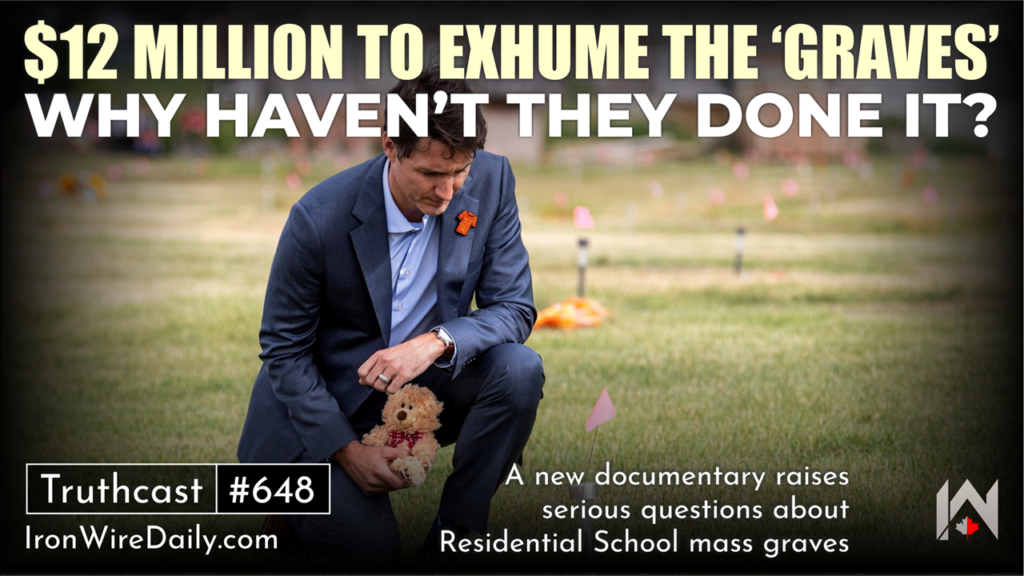LA Riots Are Globalist-Engineered
Source: The Iron Wire
(0:00 - 0:11) Good evening, I'm Will Dove. And I'm Hannah Bern, and these are the top stories for Tuesday, June 10th. In today's news, not much happened in Canada, but there have been major developments elsewhere. (0:12 - 0:31) Analysts say that the L.A. riots are not random, but orchestrated and funded by the global elites. New alarming statistics on dropping fertility around the world that will lead to a population crash. RFK Jr. has fired the entire U.S. Vaccine Committee, and robo-taxis are poised to become common on our streets. (0:33 - 1:17) Los Angeles has been at the center of renewed civil unrest, with violent protests and destruction marking the streets and raising concerns across the United States. According to recent reports, these events are not spontaneous outbursts of public frustration, but instead are being described as orchestrated and lavishly funded operations driven by the globalist elite and their radical left-wing allies. Violence and aggression have once again erupted in the city, with anti-ICE demonstrations currently gripping Los Angeles and further large-scale anti-Trump protests, dubbed No Kings, planned for this coming weekend across the nation. (1:18 - 1:54) Observers are drawing parallels to previous waves of unrest, including the Occupy Wall Street movement of 2011 and the Black Lives Matter riots in 2020. These events, it is argued, share a common thread— direct or indirect encouragement, if not outright direction, from political and business elites who are accused of seeking to reshape society according to a radical agenda. Analysts contend that the chaos in Los Angeles is a deliberate tactic which encourages violence, then accuses authorities who respond of authoritarianism. (1:55 - 2:15) This, it is argued, creates a pattern where law and order are stifled in favor of continued unrest. The scale and duration of the current riots are not matched by spontaneous public outcry alone. Instead, evidence points to significant financial backing and organization. (2:15 - 2:57) A notable figure cited is Christy Walton, a Walmart heiress, who reportedly funded a nationwide anti-Trump newspaper advertisement calling for a day of defiance on June 14. Meanwhile, Rebecca Pringle, the president of the National Education Association, is seen mobilizing protesters with rhetoric critical of lawful deportation raids. These actions are portrayed as part of a broader coalition effort by far-left NGOs, reportedly numbering up to 200, to reignite protest movements and attract donor money, especially as traditional funding sources like USAID and ActBlue appear to be drying up. (2:58 - 3:25) Funding for protest activity is not only high-level but also direct. Reports highlight Craigslist job postings offering protesters $6,500 to $12,500 per week, targeting individuals willing to sustain unrest for extended periods. This financial incentive is seen as an open invitation for those willing to engage in violent or disruptive behavior to join the movement. (3:26 - 4:07) As the situation unfolds, the fear is that these riots will not remain confined to Los Angeles but will spread across America in the coming days, with planned events already scheduled for major cities. What is clear from these reports is that the unrest is being interpreted as a calculated strategy to dominate public discourse, weaken opposition, and accelerate the transformation of Western society according to a radical globalist vision. A new report from the United Nations Population Fund, UNFPA, has sounded the alarm on a global phenomenon. (4:07 - 4:45) Fertility rates are now in steep and unprecedented decline. The UN agency, which focuses on reproductive rights, is now highlighting the personal and societal barriers that are discouraging people from having as many children as they once expected or desired, a shift from its previous focus on overpopulation and contraception. The UNFPA survey, which included 14,000 participants across 14 countries, a mix of low-, middle-, and high-income nations representing a third of the global population, found that one in five respondents say they haven't had, or do not expect to have, the number of children they want. (4:46 - 5:12) Dr. Natalia Kanem, head of the UNFPA, described the decline as a real crisis, noting that Most people surveyed want two or more children. Fertility rates are falling in large part because many feel unable to create the families they want. Within the surveyed group, 39% cited financial limitations as a major barrier to having more children, responses ranging from a high of 58% in South Korea to a low of 19% in Sweden. (5:13 - 5:51) Meanwhile, 12% of people overall identified infertility as the main reason for undershooting their family goals, and that figure was notably higher in Thailand, 19%, the U.S., 16%, South Africa, 15%, Nigeria, 14%, and India, 13%. Expect infertility rates to climb as children, who were COVID-vaxxed, reach maturity and discover that the shots have made them sterile. Demographer Anna Rotkirch, who has advised the Finnish government, noted that more people are falling short of their desired family size than surpassing it. (5:51 - 6:08) She was particularly struck that 31% of respondents over age 50 said they had fewer children than they wanted. The report serves as a pilot for larger research expected to expand to more than 50 countries later in the year. The message from experts and the UNFPA is clear. (6:09 - 6:54) The challenge is not an abstract demographic problem, but a lived crisis for millions of families caught between economic pressures, time constraints, and changing expectations. As many countries, including Canada, rely upon a growing population to support social programs such as unemployment insurance, healthcare, and old-age pensions, expect to see many of these programs disappear in the coming decades. U.S. Health Secretary Robert F. Kennedy Jr., long known for his skepticism towards certain vaccines, has made a dramatic move by terminating every member of the U.S. Influential Advisory Committee on Immunization Practices, a group responsible for issuing critical federal vaccine recommendations. (6:55 - 7:25) Kennedy's action, announced in an editorial for The Wall Street Journal, removes all 17 panel members, several of whom were appointed just months ago during the final days of President Biden's term. Kennedy justified the move by citing persistent conflicts of interest among committee members, which he claims have eroded public trust in vaccination programs. In his editorial, Kennedy did not dispute the personal integrity of committee members. (7:25 - 7:59) Rather, he suggested that systemic issues, including extensive financial ties between ACIP members and pharmaceutical companies that market vaccines, have shaped the committee's decision-making, leading to what he described as a narrow pro-industry orthodoxy. Members of ACIP are required to disclose conflicts of interest and are expected to recuse themselves from votes when such conflicts are present. But Kennedy argues that the very structure of the incentives has compromised the committee's independence. (8:00 - 8:32) Upon approving vaccines, the FDA is tasked with assessing whether benefits outweigh risks. ACIP's subsequent recommendations determine which groups receive vaccines and when, which in turn affects insurance coverage. Peter Lurie, a former FDA official, cautioned that if Kennedy replaces committee members with vaccine skeptics, some vaccines might no longer be recommended and insurance reimbursement for shots could be jeopardized, potentially leading to lower vaccination rates and increased disease incidence. (8:33 - 8:49) Why don't I see that as a bad thing, Hannah? The autonomous vehicle, AV industry, has reached a critical milestone. Robo-taxis have officially entered the commercialization phase in North America. Heralding a new era for mobility and logistics. (8:51 - 9:24) As reported by a team of Goldman Sachs analysts led by Mark Delaney, robo-taxis and autonomous trucks are not just pilot projects any longer, but are now proliferating into the real economy at a rapid pace. Currently, the U.S. ride-sharing market is valued at $58 billion a year, but Goldman Sachs forecasts it will balloon to over $336 billion by 2030. Robo-taxis, the self-driving cars operated by companies like Waymo and Tesla, are set to claim an increasing share of this massive market. (9:25 - 9:52) Specifically, analysts project robo-taxis will capture about $7 billion of the ride-share sector by 2030, which equates to approximately 8% of total ride-share bookings. This represents a dramatic rise from just $300 million in projected revenue for 2025, signaling a nearly 90% compound annual growth rate over the next five years. Currently, Canada has no commercial robo-taxi services. (9:53 - 10:22) However, there are over 500,000 semi-autonomous vehicles on our roads, and active pilot projects in Toronto and Waterloo involve small numbers of delivery and research vehicles. Waymo stands out as the current leader in the commercial AV space in the United States. The company, which is Google's autonomous vehicle subsidiary, already has over 1,500 robo-taxis operating across major U.S. metro areas such as Phoenix, San Francisco, Los Angeles, and Austin. (10:23 - 10:45) These vehicles collectively complete over 250,000 paid rides each week, demonstrating both the operational maturity and growing consumer acceptance of autonomous mobility solutions. Waymo's infrastructure and network are set for further expansion, with plans to serve seven U.S. cities by the end of 2026. Tesla is also poised to make a splash. (10:46 - 11:18) The electric vehicle manufacturer is preparing to launch its own robo-taxi service in Austin, Texas, later this week, marking a significant step toward broader commercialization. With these developments, Goldman Sachs expects to see over 1,800 commercial autonomous vehicles in service across the United States by the end of 2025, climbing to an ambitious 35,000 by 2030. Beyond passenger ride-sharing, AV technology is making inroads into logistics and heavy-duty trucking. (11:19 - 11:51) Autonomous Class 8 trucks, those with a gross vehicle weight rating above 33,000 pounds, are already being tested and deployed on American public roads. Although they remain a small fraction of the market today, Goldman analysts forecast 25,000 AV trucks on the road by 2030, capturing $18 billion in the freight market and nearly 3% of total trucked miles. These vehicles promise to lower transportation costs and increase operational efficiency by eliminating driver time restrictions. (11:52 - 11:59) I'm Will Dove. And I'm Hannah Bern. And those are the top stories for today, Tuesday, June 10th.
2 Comments
Leave a Comment Cancel Reply
You must be logged in to post a comment.
















Try to relax a little more. You have something waaay better to offer than the MM talking heads. Remember that when you’re delivering the news! You outclass them on every level so you don’t need to act like them….
Love this new IronWire concept. Keep up the good work Will and Hannah